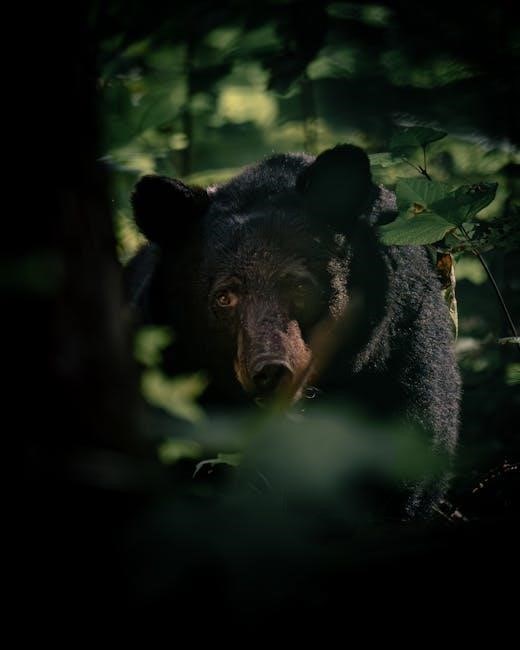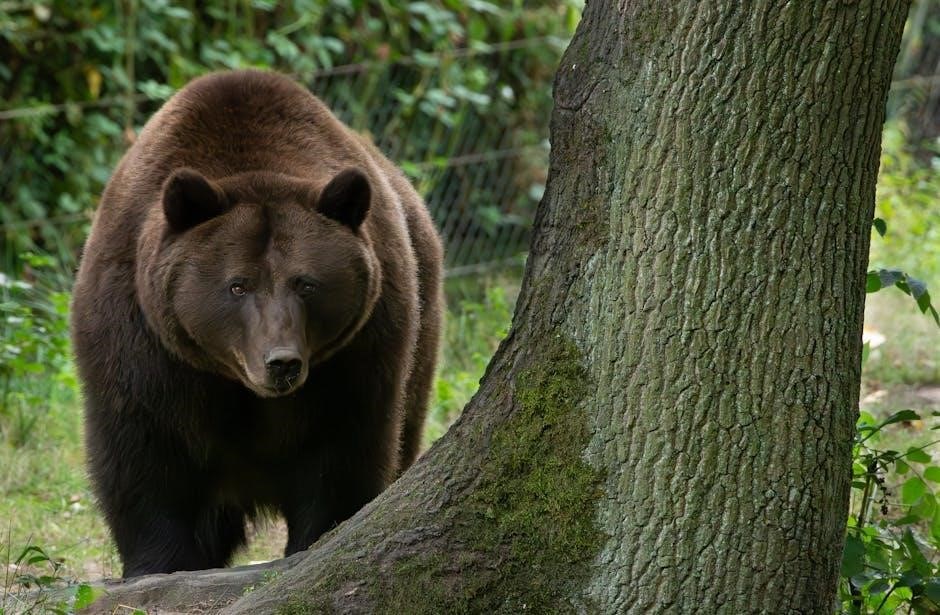The Bear and the Piano PDF is a popular digital version of David Litchfield’s heartwarming tale. Available on Amazon Kindle and Daunt Books, it offers features like bookmarks, highlighting, and readability on multiple devices, making it a convenient choice for readers worldwide.
1.1. Overview of the Book
The Bear and the Piano is a captivating children’s story written and illustrated by David Litchfield. It follows the journey of a young bear cub who discovers an abandoned piano in the forest. Intrigued by the strange object, the bear begins to explore its musical possibilities, leading to a transformative experience. Over time, the bear masters the piano, and his love for music resonates deeply with the other forest animals. The story is a heartwarming tale of curiosity, passion, and the power of art to connect and inspire. With its stunning illustrations and emotional depth, the book has become a beloved choice for both children and parents.
1.2. The Significance of the Piano in the Story
The piano in The Bear and the Piano serves as a central symbol of discovery, connection, and transformation. It represents the bear’s gateway to a world beyond his forest home, sparking curiosity and creativity. The piano’s presence not only changes the bear’s life but also unites the forest animals through the power of music. It symbolizes the idea that art can transcend boundaries and create meaningful bonds. The piano’s journey, from abandonment to becoming a source of joy, mirrors the bear’s own growth. Its significance lies in its ability to evoke emotions and bring people together, highlighting the universal language of music and its profound impact on lives.
1.3. The Author and Illustrator: David Litchfield
David Litchfield is the talented author and illustrator behind The Bear and the Piano. Known for his captivating storytelling and stunning visual artistry, Litchfield has gained widespread acclaim for his work. With a background in art and design, he brings a unique perspective to children’s literature. His illustrations in The Bear and the Piano are atmospheric and emotive, perfectly complementing the narrative. Litchfield’s passion for storytelling and his ability to convey deep emotions through art have made the book a cherished read. His work has also been recognized with awards, further highlighting his contribution to the world of children’s books. Through this story, Litchfield continues to inspire readers of all ages with his creative vision and heartwarming tales.
1.4. Availability of the PDF Version
The PDF version of The Bear and the Piano is widely available for readers seeking a digital format. It can be purchased or downloaded from various online platforms, including Amazon, Google Books, and eBay. Many websites offer the PDF for easy access, allowing readers to enjoy the story on their devices. Additionally, some libraries and eBook platforms provide the PDF as part of their collections. For those interested in a digital copy, it is advisable to check authorized retailers to ensure a high-quality and legal download. The PDF format makes the book portable and convenient, enabling readers to explore the heartwarming tale of the bear and his piano anytime, anywhere.

Plot Summary of “The Bear and the Piano”
The Bear and the Piano follows a bear who discovers a mysterious piano in the forest. His curiosity sparks a journey of learning, passion, and unexpected outcomes.
2.1. The Discovery of the Piano in the Forest
In the heart of the forest, a curious bear stumbles upon a mysterious piano left behind by humans. The piano, with its polished surface and intricate keys, seems out of place in the natural setting. Intrigued, the bear cautiously approaches the instrument, drawn by its unfamiliar shape and allure. Despite initial hesitation, he touches the keys, producing a resonant sound that echoes through the trees. This moment sparks a deep connection, marking the beginning of an extraordinary journey. The piano becomes a source of wonder and discovery, bridging the gap between the wild and the musical world.

2.2. The Bear’s Early Attempts to Play
The bear’s curiosity leads him to experiment with the piano, though his initial attempts are clumsy and awkward. His large paws struggle to press the delicate keys, resulting in discordant sounds that startle the forest creatures; Despite the unpleasant noises, the bear persists, captivated by the piano’s potential. He learns through trial and error, gradually discovering how to produce softer, more melodious tones. The process is slow, but his determination grows with each attempt. The forest becomes his classroom, and the piano, his teacher, guiding him toward a deeper understanding of music and himself. These early efforts lay the foundation for his remarkable journey.
2.3. The Bear’s Mastery of the Piano Over Time

Over time, the bear’s dedication and passion for the piano transform his clumsy attempts into beautiful music. Through disciplined practice, he develops a deep understanding of the instrument, learning to create elegant melodies that resonate through the forest. The once-discordant sounds evolve into captivating performances, drawing the attention of the forest creatures. They gather around, mesmerized by the bear’s talent, as he plays with grace and emotion. His mastery of the piano becomes a source of inspiration, showcasing how perseverance and passion can lead to extraordinary achievements. The bear’s journey from curiosity to mastery is a testament to the power of dedication and the transformative impact of music.

2.4. The Emotional Journey and Final Note
The bear’s emotional journey reaches its peak as he confronts the dilemma of staying in the forest or pursuing fame. Torn between his love for the piano and his forest home, he makes a heartfelt decision. The final note he plays is a poignant farewell to his life in the forest, leaving a lasting impact on the animals who have grown to cherish his music. The story concludes with a bittersweet resolution, emphasizing the sacrifices made for passion and the enduring power of music to connect and inspire. The bear’s final performance becomes a memorable testament to his emotional growth and the transformative power of art.

Themes and Symbolism in the Book
The story explores themes of perseverance, passion, and identity, with the piano symbolizing the transformative power of music and the forest representing isolation and discovery.
3.1. The Power of Music to Transform Lives
The story beautifully illustrates how music can profoundly change a life. The bear discovers the piano, and through his journey, music becomes his passion and purpose. It transcends his isolation, connecting him to something greater than himself. The piano acts as a bridge between the bear and the other animals, fostering understanding and unity. Music transforms not only the bear but also those who listen, showcasing its universal language and emotional depth. This theme highlights how dedication to an art form can reshape identity and bring joy to both the creator and the audience. The bear’s transformation underscores the idea that music has the power to elevate and inspire, making it a central message of the story.
3.2. The Importance of Perseverance and Passion

The story emphasizes the transformative power of perseverance and passion. The bear’s journey with the piano is marked by initial struggles and challenges, but his unwavering dedication leads to remarkable growth. Despite the skepticism of others, the bear persists, driven by his passion for music. Over time, his efforts pay off, and he becomes a masterful player, inspiring those around him. This theme highlights the idea that talent alone is not enough; it is the consistent effort and love for an art form that truly lead to success. The bear’s journey teaches readers the value of staying committed to their passions, even in the face of adversity, and how this can lead to personal fulfillment and recognition.
3.3. The Symbolism of the Forest and the Piano
The forest in The Bear and the Piano symbolizes solitude, discovery, and the natural world, while the piano represents creativity, opportunity, and connection. The piano, found deep in the forest, serves as a catalyst for the bear’s journey, bridging his isolated life with a broader world. The forest embodies the bear’s initial seclusion, while the piano symbolizes the unexpected arrival of something extraordinary. Together, they illustrate how discovery can transform lives and challenge the boundaries of one’s environment. The contrast between the wild, untamed forest and the refined, human-made piano highlights the tension and beauty of intersecting worlds. This symbolism underscores the story’s themes of exploration, growth, and the impact of external influences on personal identity.
3.4. The Concept of Identity Through Art
In The Bear and the Piano, the bear’s journey with the piano explores how art shapes identity. The piano becomes a tool for self-expression, allowing the bear to discover his purpose and passion. Through his dedication to music, the bear transitions from being an anonymous forest creature to a unique individual with a distinct voice. His identity evolves as he masters the piano, revealing a deeper understanding of himself and his place in the world. The story highlights how art can transform and define who we are, offering a sense of belonging and fulfillment. The bear’s connection to music becomes central to his identity, showcasing the profound impact of artistic expression on personal growth and self-discovery. This theme resonates deeply, emphasizing the importance of pursuing one’s passions.
Educational and Literary Significance
The Bear and the Piano is celebrated for its emotional depth, vivid illustrations, and universal themes; It aligns with early learning goals, fostering creativity and empathy in children;
4.1. Early Learning Goals (ELGs) and Resources
The Bear and the Piano supports early learning goals by fostering creativity, emotional intelligence, and language development. The story encourages children to explore their passions, aligning with ELGs for personal, social, and emotional development. Teachers can use the book to teach storytelling, empathy, and perseverance. The PDF version of the book is a valuable resource, offering vivid illustrations and a poignant narrative that captivates young learners. It can be integrated into classroom activities, such as group discussions, art projects, and music appreciation sessions. Additional resources, like activity sheets and discussion guides, are available online, making it a comprehensive tool for educators aiming to meet ELGs while nurturing a love for reading and the arts.
4.2. Literacy Shed Plus Activities
Literacy Shed Plus activities are designed to enhance learning through creative and engaging approaches. For The Bear and the Piano, educators can use the PDF version to create film-based literacy lessons. Activities include analyzing the story’s emotional depth, exploring themes through discussion, and creating visual responses to key scenes. Pupils can craft their own narratives inspired by the bear’s journey, while teachers can incorporate music and art to deepen understanding. The PDF’s vivid illustrations make it ideal for visual literacy exercises, such as identifying symbolism and mood. These activities align with curriculum goals, fostering critical thinking, creativity, and a love for storytelling. They also provide opportunities for differentiation, ensuring all learners can engage meaningfully with the text.
4.3. Classroom Discussions and Storytime Ideas
Classroom discussions and storytime ideas for The Bear and the Piano can be tailored to foster deep engagement and reflection. Teachers can begin by asking pupils to share their initial thoughts on the bear’s discovery of the piano. Discussions can explore themes such as curiosity, perseverance, and the impact of music on emotions. Storytime can be enriched by playing musical excerpts to accompany key moments in the story. Additionally, educators can encourage pupils to create their own soundtracks for the bear’s journey, linking music appreciation with literacy. Group activities, such as role-playing the bear’s emotional transformations, can also deepen understanding. These interactive approaches make the story accessible and memorable for young learners, while aligning with educational goals.
4.4. The Role of the Book in Teaching Music Appreciation
The Bear and the Piano serves as a powerful tool for teaching music appreciation, introducing young readers to the emotional depth of music. The story highlights the piano as a medium for self-expression and connection, allowing educators to discuss musical elements like melody and rhythm. Teachers can use the bear’s journey to explore how music evokes feelings and unites people across cultures. The book’s themes align with music education goals, encouraging pupils to reflect on how music can transform lives. By integrating the story into music lessons, educators can inspire curiosity and appreciation for the arts. This makes The Bear and the Piano a valuable resource for fostering musical understanding and creativity in students.
Media and Adaptations
The Bear and the Piano has been adapted into an animated film and narrated by Joanna Lumley, enhancing its reach and emotional impact.
5.1. The Animated Film Adaptation
The Bear and the Piano has been beautifully adapted into an animated short film, bringing the story to life with stunning visuals and heartfelt music. Produced by a renowned animation studio, the film captures the bear’s journey from discovery to stardom, staying true to the book’s emotional core; Joanna Lumley’s narration adds depth and warmth, while the animation enhances the magical atmosphere of the forest and the piano’s significance. The film has received critical acclaim, winning several awards for its storytelling and artistic excellence. It serves as a perfect complement to the book, offering a new way to experience the bear’s inspiring tale. The adaptation retains the original’s themes of passion and perseverance, making it a beloved choice for both children and adults.

5.2. Joanna Lumley’s Narration of the Story
Joanna Lumley, a renowned British actress and author, brings her iconic voice to the narration of The Bear and the Piano. Her warm, expressive tone perfectly captures the story’s emotional depth, making the tale even more engaging for listeners. Lumley’s narration complements the book’s themes of music, perseverance, and identity, adding a layer of sophistication and charm. Her involvement has drawn widespread acclaim, enhancing the story’s appeal to both children and adults. Lumley’s storytelling ability ensures that the bear’s journey resonates deeply, making her narration a delightful addition to the story’s legacy. Her contribution has further cemented the book’s place as a beloved modern classic.
5.3. Reviews and Ratings of the Book
The Bear and the Piano has received widespread critical acclaim, with readers and critics praising its heartfelt story and stunning illustrations. The book holds an average rating of 4.5 stars on platforms like Amazon and Goodreads, with many reviewers highlighting its emotional depth and universal themes. Parents and educators frequently recommend it for its ability tospark imagination and empathy in children. The story’s uplifting message about passion and perseverance resonates with readers of all ages, making it a modern classic. Its high ratings and glowing reviews underscore its impact as a cherished tale in children’s literature.
5.4. Social Media and Community Responses
Social media platforms have been flooded with positive responses to The Bear and the Piano, with readers sharing heartfelt reactions and fan art. Parents and educators often post photos of the book in classrooms, highlighting its impact on children. The story’s emotional depth has sparked conversations about music, perseverance, and following one’s dreams. Online communities, such as Facebook groups and Reddit threads, frequently discuss the book’s themes and its ability to connect with readers of all ages. Many users have praised the illustrations and the uplifting message, making it a popular topic in literary circles. The book’s resonance on social media underscores its enduring appeal and the strong emotional bond it creates with its audience.

Availability and Purchase Options

The Bear and the Piano is widely available in various formats, including hardcover, paperback, and digital versions. Readers can purchase it from major online retailers like Amazon, Barnes & Noble, and independent bookstores. The book is also accessible through libraries and educational platforms, making it easy for readers worldwide to access and enjoy this heartfelt story.
6.1. Amazon Purchase Links for the Book
The Bear and the Piano can be easily purchased on Amazon in various formats, including hardcover, paperback, and Kindle editions. To find the PDF version, visit the Amazon product page for the book and explore the “Formats” section. Simply search for “The Bear and the Piano” on Amazon’s homepage, and browse through the available options. Ensure you select the correct edition, as some listings may be for the physical book only. Amazon often provides fast delivery options for both physical and digital copies, making it a convenient choice for readers worldwide. Additionally, customer reviews and ratings are available to help you make an informed purchase.
For the PDF version, check the Kindle Store or look for digital download options on the product page. If unavailable, consider the paperback edition, which is widely stocked.
6.2. The Kindle Edition and Its Features
The Kindle edition of The Bear and the Piano offers a convenient and engaging reading experience. It features adjustable font sizes, allowing readers to customize their reading comfort; The digital format also includes night mode for reading in low-light environments. One notable feature is the ability to highlight and bookmark favorite passages, enhancing the storytelling experience. Additionally, the Kindle edition preserves the vibrant illustrations by David Litchfield, ensuring that the visual charm of the book is maintained in its digital form. Readers can easily purchase and download the book from Amazon’s Kindle Store, making it accessible on Kindle devices and the free Kindle reading apps for iOS and Android; This ensures that the story can be enjoyed anytime and anywhere, adding to its accessibility and appeal.
6.3. Board Book Edition by Daunt Books
The Board Book Edition of The Bear and the Piano, published by Daunt Books, is a sturdy and compact version designed for younger readers. Its thick, durable pages make it perfect for little hands, while the vibrant illustrations by David Litchfield remain intact, capturing the story’s emotional depth. This edition is ideal for early learning, introducing children to the magical tale of the bear and his piano. Daunt Books’ attention to detail ensures a high-quality finish, making it a delightful addition to any child’s bookshelf. The board book format is particularly appealing for libraries and classrooms, where durability is key. It’s a charming way to share the story with preschoolers, fostering a love for music and storytelling from an early age.
6.4. Worldwide Shipping and Availability
The Bear and the Piano is widely available globally, with numerous retailers offering shipping to almost every country. Online platforms like Amazon, Book Depository, and Waterstones provide convenient access, ensuring the book reaches readers worldwide. The paperback, hardcover, and Kindle editions are particularly popular, with many sellers offering fast and reliable delivery options. Additionally, the PDF version of the book can be purchased and downloaded from select online stores, making it easily accessible to a global audience; Regional bookstores and libraries also carry copies, further expanding its reach. This widespread availability ensures that readers of all ages can enjoy the heartwarming tale of the bear and his piano, no matter where they are in the world.
